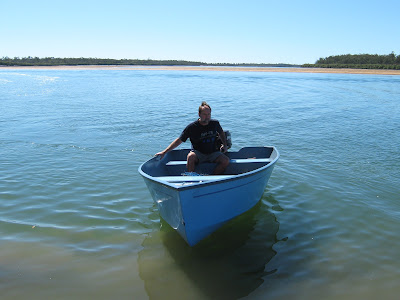Years ago when we used to live on our 43 ft yacht, we were in Cairns at the time building a multihull for a client. Anchored in front of us was the 35 ft Trimaran owned by a couple called John and Jan. Well… they had this Niad inflatable dinghy where the side sponson's had a habit of going flat all the time.
One day they popped around with set of plans for a flat bottom skiff, asking could we build this dinghy for them. Taking one look at it I commented that as tender, it was useless and we could design and build something far better, something where your not pounding and ripping your spine out through the roof of your mouth. They agreed and over the next couple of days I drew up this small dinghy and taking it around... they loved it.
Just up from the Coconut slipway, there was a farmer (Ted) who agreed to let us use one of his sheds, so we moved our boat up there and began building it. As usual, other yachties heard that we were building this dinghy for John and Jan and would pop around to have a look.
“Who the dinghy for?” they would ask
“Mushulu” Id reply
“Oh...Ok”
You see, when you live on a yacht, no one knows your last name. The name of the boat “becomes” your last name. In this case it was John and Jan from Mushulu...the “name” of their Trimaran. Now you know where the name comes from.
As for the design itself, you see, as a tender, your boat is akin to a work truck.. With fuel runs, water funs, shopping runs and not including the exploring and fishing, tenders get hammered hard. One of the biggest problems with the majority of dinghies is the freeboard is too low and they are heavy. Doing all these things and more, any water or waves when loaded has a habit of slopping over the side. (Nothing worse than having wet shopping bags I can tell you). So the first thing I designed into the Mushulu was high sides.
They also have to be light, but not too light as it makes for poor sea keeping. They also need to have loads of internal space for carrying things ( when doing a water run, I used to carry 8 x 20 litre jerry cans in ours. That's 160 litres) and…. when swamped, it must float level.
You would not believe how many times over the years where I saw dinghies where they had been left down for the night and a huge thunderstorm or heavy rain would come during the night only to see these dinghies with their outboards attached…sunk and lying on the bottom. With ours, if it rained, the dinghy simply filled (still floating level) and the excess water would simply drain out over the top of the transom. All I had to do was jump in, bail the water out and 10 minutes later …go wherever. No problems. It was surprising how many “Mushulu’s” we built for various yachties over the years when we lived on our yacht. It was a proven design and it work like magic not only as a work truck, but also as a fishing and exploration dinghy..even offshore.
Anyway… after eleven years of cruising throughout Australia and Asia (we were in Singapore preparing the boat for a cruise to Japan when Sept 11th happened, everything changed. The whole mood of cruising took a different outlook and things were no longer the same.
So with this in mind, we sold our 42 ft Catamaran and moved back ashore. It was here that I found my old “Mushulu 12” plans (the original) and later when we started BMD, we decided to bring the design out as a part of our plan portfolio.



No comments:
Post a Comment